"Computers don't make mistakes. What they do, they do on purpose." -Dale Gribble, King of the Hill
Alright, so I know you're all impatient with the most burning Starts With A Bang! question of all: what was Ethan for Halloween? Well, without further ado, I'd like to introduce you to my avatar for the next 12 months: King Triton from Disney's The Little Mermaid!



 With that said, I'm already thinking about the next Starts With A Bang podcast (maybe on parallel Universes?) and heading to the finish line of my next book, Treknology, about the real-life science behind the technological advances envisioned by Star Trek. If all goes according to plan, it should be out October 2017!
With that said, I'm already thinking about the next Starts With A Bang podcast (maybe on parallel Universes?) and heading to the finish line of my next book, Treknology, about the real-life science behind the technological advances envisioned by Star Trek. If all goes according to plan, it should be out October 2017!
Now, science-wise, what have you missed this past week? Check it all out:
- Do 234 Sun-like stars show evidence for aliens? (for Ask Ethan),
- Saturn's hexagon brings new, colorful mysteries (for Mostly Mute Monday),
- Why are dark matter and modified gravity in such conflict?,
- New impact hypothesis might explain our Moon's uniqueness,
- How does the CMB tell us what's in the Universe?, and
- Five independent signs of new physics in the Universe.
As always, these stories all appear ad-free on a 1-week delay over at Medium, this is all possible thank to the donations of our Patreon supporters, and I can already foresee this coming week having a slew of stories on Mars, whether our Solar System is rare or not, and a whole lot more. But before we jump forward, let's take a look back at the best of our comments of the week!
 Image credit: Wikimedia Commons user Lunch, of a 2-D projection of a Calabi-Yau manifold, one popular method of compactifying the extra, unwanted dimensions of String Theory.
Image credit: Wikimedia Commons user Lunch, of a 2-D projection of a Calabi-Yau manifold, one popular method of compactifying the extra, unwanted dimensions of String Theory.
From Wow on the possibility of higher-dimensional shortcuts: "Aye, but we’d have little chance of getting to any particular spot any quicker, since the disconnect is to every available point in reality, and there’s no more reason to think that it’s possible to get to mars that way (for example) than to a galaxy far, far away."
This is actually a huge, important point when it comes to the science of transporting materials by wormhole from one location to another. While we normally envision a "hole" in spacetime as connecting to whatever point we desire -- from Earth to Mars, from a location in our galaxy to one on the other side of our galaxy, from here to Andromeda, etc. -- the reality is that there are only two likely real-Universe outcomes for wormholes:
- The connection of two regions where the curvature of space is extreme, e.g., between two black holes.
- A connection between two regions that have nothing to do with one another, but happen to be nearby or connected as viewed from higher-dimensional space.
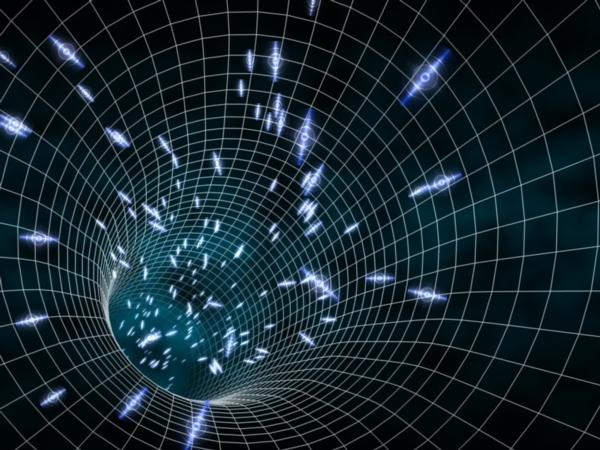 Image credit: ©2009–2014 stefitms of deviantART, via http://stefitms.deviantart.com/art/Wormhole-136427693.
Image credit: ©2009–2014 stefitms of deviantART, via http://stefitms.deviantart.com/art/Wormhole-136427693.
This all but eliminates convenient, human-chosen links between a start point and a destination. In other words, even if you could take a higher-dimensional shortcut to another location, the likelihood it would take you someplace you actually wanted to go is astronomically tiny.
 Image credit: wikimedia commons user Tauʻolunga, released into the public domain, of the Earth in orbit around the Sun, with its rotational axis shown.
Image credit: wikimedia commons user Tauʻolunga, released into the public domain, of the Earth in orbit around the Sun, with its rotational axis shown.
From Jenora Feuer on stable orbits and gravity: "I remember back in University spending much of a class going through a perturbative analysis that gave R^-2 as the only form of gravity that produced truly stable orbits; both R^-1 and R^-3 are unstable in the long term. The idea was that this implied that complex gravitational structures could only happen in three dimensions."
This is mostly true! If you want a stable orbit, there are only two forms your potential can take to produce it: a 1/r potential (like a Coulomb force) or an r^2 potential (like a spring, or harmonic oscillator, force). That's it; no other form of a physical potential gives you a closed orbit. This is a difficulty that, for example, any alternative theory of gravity must face.
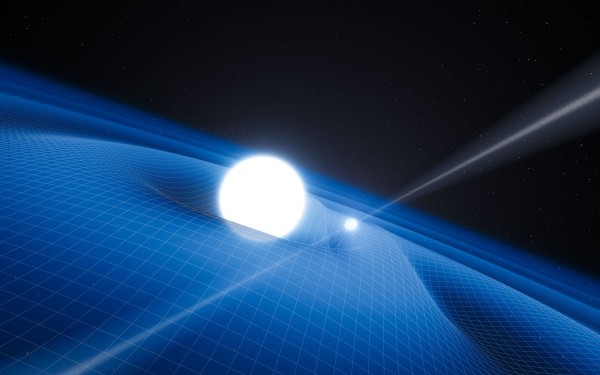 Image credit: ESO/L. Calçada, of a pulsar orbiting a binary companion and the gravitational waves (or ripples) in spacetime that ensue as a result.
Image credit: ESO/L. Calçada, of a pulsar orbiting a binary companion and the gravitational waves (or ripples) in spacetime that ensue as a result.
But don't be fooled by thinking this means gravity must be an inverse square force, which is the force that arises from a 1/r potential. In fact, Einstein's General Relativity is not. This is why orbits decay, why gravitational waves exist and why the orbits of the planets precess in a way that doesn't agree with Newton's theory. Gravity does not give a perfectly stable orbit. Thankfully, the departure of our gravitational theory from this form is small, at least compared to the timescales on which orbits occur. It will take approximately 10^150 years for Earth to spiral into the Sun from gravitational radiation, for instance; lots of other, worse things will happen first.
The correct version of your instructor's statement would have been, "complex gravitational structures in three dimensions that are eternally stable can only occur with an inverse-square gravitational force." But wait some 10^22 years and watch the stars and stellar corpses get ejected from the galaxy, and see how "stable" things look then!
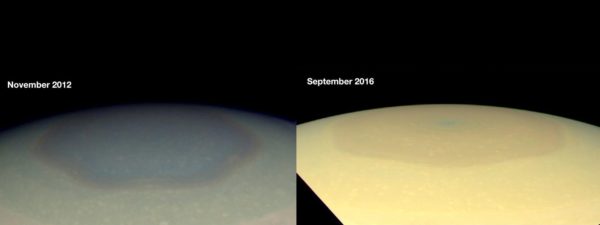 A 2012 (L) and a 2016 (R) image of Saturn's north pole, both taken with the Cassini wide-angle camera. Images credit: NASA / JPL-Caltech / Space Science Institute.
A 2012 (L) and a 2016 (R) image of Saturn's north pole, both taken with the Cassini wide-angle camera. Images credit: NASA / JPL-Caltech / Space Science Institute.
From Sinisa Lazarek on Saturn's changing hexagon. Kind of: "Forbes’ addblock wall is up and running again"
Apparently, it depends on whether you are lucky, unlucky or were first lucky and then not. For some people, the adblock wall went down a few months ago; for some people, it always remained up. Incrementally, more people who had the wall go down have seen it go back up, although it's not up for everyone. So either:
- it went down for you and stayed down,
- it went down for you and then went back up,
- or it always stayed up for you.
That's the full suite of options. But there's been another recent change that I'm a bit irate about.
That's right, there are now auto-play videos in the corner of every post. My normal trick of de-facto disabling flash doesn't have any effect, as the video auto-plays no matter what. And there's an unblockable ad that comes through when that happens as well. This is an insidious 2013 trick to up video views, and it appears that Forbes has brought this into every post. How unfortunate.
The X-ray (pink) and overall matter (blue) maps of various colliding galaxy clusters show a clear separation between normal matter and dark matter. Image credit: X-ray: NASA/CXC/Ecole Polytechnique Federale de Lausanne, Switzerland/D.Harvey & NASA/CXC/Durham Univ/R.Massey; Optical & Lensing Map: NASA, ESA, D. Harvey (Ecole Polytechnique Federale de Lausanne, Switzerland) and R. Massey (Durham University, UK).
From Ted Murphree on dark matter vs. MOND: "I find it strange and amusing that each camp is emotionally invested in the controversy, hoping that their idea is right. Why? The real excitement is discovering the scientific truth, whatever it may turn out to be."
This is what most non-scientists (and a small percentage of scientists) think about how science ought to be. And perhaps it is, for those of us who are 100% dispassionate, and who don't get attached to the ideas we work on. But for the vast majority of scientists, at least in my experience, being a scientist is mixed up with being human. And that means having biases, usually towards wanting our ideas to be correct. If you've devoted years or decades of your life to researching an idea, it's easy to convince yourself of that. It's so easy that, for a great many scientists, even overwhelming evidence won't convince you otherwise.
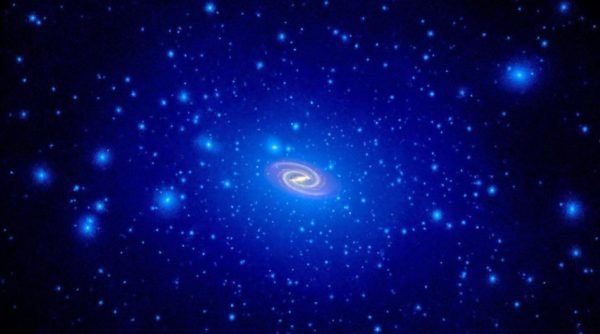 The details of the small-scale structure predicted by dark matter do not match with what we observe. The hope of the dark matter camp is that improved simulations and models will come to reproduce them accurately and robustly. Image credit: NASA, ESA, and T. Brown and J. Tumlinson (STScI).
The details of the small-scale structure predicted by dark matter do not match with what we observe. The hope of the dark matter camp is that improved simulations and models will come to reproduce them accurately and robustly. Image credit: NASA, ESA, and T. Brown and J. Tumlinson (STScI).
Pavel Kroupa, one of the most adamant anti-dark-matter people, has said that even if we directly detect it he won't believe that it's responsible for the missing mass problem for galaxies. Fred Hoyle, one of the 20th century's greatest physicists, refused to accept the Big Bang for forty years after it's confirmation, despite the overwhelming evidence. The people who are MOND advocates are well-convinced that their approach is correct, that the flaws with dark matter are dealbreakers, and that it's only a matter of time and work before they are vindicated. I don't think that's what the data indicates; I think it far supports the opposite conclusion: that MOND is a phenomenological curiosity and that it will likely emerge from the full dark matter theory.
Of course, the evidence will decide in the end. But that doesn't mean scientists will be completely dispassionate about the likelihood of the outcomes until then. After all, we're only human.
From Anonymous Coward on hypothetical planets: "I was wondering though if there actually is a plausible orbit for Vulcan under Newtonian mechanics that is capable of reproducing the precession in the orbit of Mercury, which we now understand to be caused by relativistic effects."
There is: it's indicated above. The right combination of planetary orbits and masses can lead to additional precession, and the range of orbits shown above would have accomplished that under Newtonian physics. Of course, that's been ruled out observationally (no Vulcan) and now, theoretically, there's no need for it due to Einstein. General Relativity also explains what would, under Newton's scheme, be anomalies in the orbits of Venus, Earth and Mars, all at a significant level. Even if it were reliant only on the orbits of these worlds, Newton would be busted.
The details of the small-scale structure predicted by dark matter do not match with what we observe. The hope of the dark matter camp is that improved simulations and models will come to reproduce them accurately and robustly. Image credit: NASA, ESA, and T. Brown and J. Tumlinson (STScI).
From selfAwarePatterns on MOND and dark matter together: "I wonder if anyone has considered that reality might be some combination of both theories. Maybe gravitation does have to be modified, but the remaining differences at the cosmological scale require some lower portion of dark matter."
Of course it's possible, and occasionally it's considered. But it's generally regarded as a terrible approach for a simple reason: more "fixes" or tunable parameters (in general, more degrees of freedom) are less preferable to fewer when it comes to addressing a number of known problems. So if you want to solve:
- the CMB fluctuations,
- large-scale structure formation,
- intra-cluster motions,
- inter-cluster collisions,
- gravitational lensing data,
- and galactic rotation,
you are better off trying to find one "fix" to get all six. Dark matter gets five perfectly and one moderately; MOND gets one perfectly and five not-at-all. Sure, you can combine them and get all six, but if you add one "new physics" fix for every "new problem" you identify, you're playing whack-a-mole and/or adding epicycles, not moving the field forward.
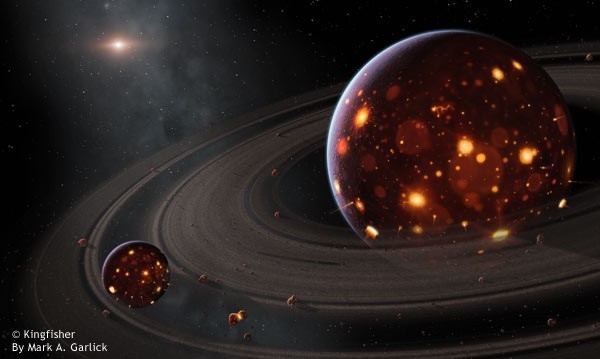 Image credit: copyright Kingfisher, art by Mark A. Garlick, retrieved from http://spaceart1.ning.com/photo/birth-of-the-moon.
Image credit: copyright Kingfisher, art by Mark A. Garlick, retrieved from http://spaceart1.ning.com/photo/birth-of-the-moon.
From Omega Centauri on the faint-young-Sun problem: "Could this have an impact on the faint young sun problem: the solar luminosity should have been low enough that even with a lot of greenhouse gases the early earth should have frozen over."
The typical solution to the faint young Sun problem is that the early Earth generated much of its own heat internally, and that -- along with a methane-rich atmosphere -- made up the heat balance enough to allow liquid water on the surface. That's the leading thought. It's conceivable that a "hot Moon" could have helped, but this new tweak to the giant impact hypothesis isn't thought to play a role compared to the longstanding version.
From Sinisa Lazarek: "This might be a bit lame question but here it goes. If Moon has a liquid metal core, similar in composition to Earth, and is rotating, why doesn’t it have a dipole magnetic field, like Earth?"
It's not simply the rotation of a metal core that produces a planet-wide magnetic field, but the presence of an active dynamo. In general, a larger planet has a larger core, and will cool in proportion to the planet's surface area. The size of the lunar core is only about 20% of its radius (versus Earth, which has a core about 50% our planet's radius), and the lunar surface area is approximately 7% of Earth's. The Moon likely had an active dynamo for a short time, and no longer does. This is probably the case for Mars, too, which has relic magnetic fields imprinted on its surface rocks, but no active, planet-wide field.
The giant impact hypothesis states that a Mars-sized body collided with early Earth, with the debris that doesn't fall back to Earth forming the Moon. Image credit: NASA/JPL-Caltech.
From EpiPete on... I guess the 2016 election: "“The likelihood that the early Earth was hit with the right properties to explain the current tilt of the moon’s orbit “is something like 30 percent,” Stewart said. “It’s reasonably likely.””
On fivethirtyeight.com, Trump’s current chance of winning: 34.1%"
Thankfully, physicists' models of lunar formation predict lunar formation a lot more accurately than Nate Silver is predicting the 2016 election.
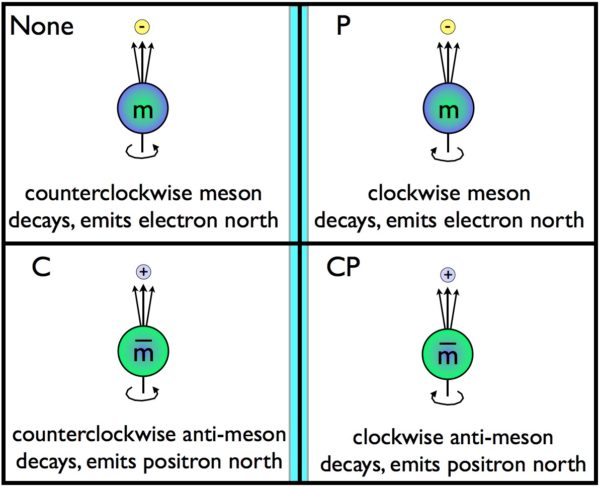 Changing particles for antiparticles and reflecting them in a mirror simultaneously represents CP symmetry. If the anti-mirror decays are different from the normal decays, CP is violated. Image credit: E. Siegel.
Changing particles for antiparticles and reflecting them in a mirror simultaneously represents CP symmetry. If the anti-mirror decays are different from the normal decays, CP is violated. Image credit: E. Siegel.
And finally from eric the impatient on the greatest physics signs beyond the Standard Model: "Ethan, you neglected the current grand American experiment being run to discover the Moron. Well I guess ‘discover’ is the wrong word; at this point we’ve discovered it and are running tests to evaluate its spin properties.
Also – what, no Halloween pics?"
You got your Halloween pics! I don't advertise them on Forbes, of course, since that's not exactly the right audience, but I happily posted them on Facebook, Twitter, Tumblr, Patreon (they get it first, of course), and even on Medium. I have a lot of internet homes! (In fact, autographed Halloween photos should go out to the most generous of my Patreon supporters this week.) As far as "discovering the Moron" as you call it, remember what George Carlin said. Think of the average person, and how stupid they are. Then realize that half of them are even stupider than that.

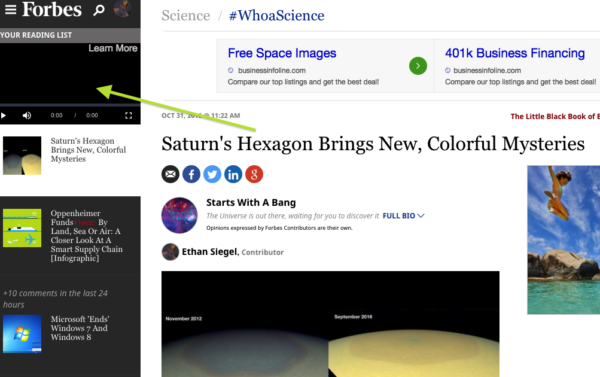


Well, some of us old fogies are luddites. On your list, my participation is: no, no, no, no and even no (except when I can't find another way to get to your articles).
Though I bow to your dedication in signing autographs for fans, and if I was in the northwest, I would be one of them. I must also say I admire your dedication to a costume theme. Frankly, I always either choose - or modify - costumes so as to allow easy movement and beer holding. :)
So now the question becomes when do we decide to stop chasing Vulcan and start looking for a new theory of gravity? Supporters of modified gravity frequently accuse supporters of dark matter metaphorically "adding more epicycles" to make their theories work. But then I take a look at the TeVeS version of the Einstein field equation and their tortured explanations of the Bullet Cluster and other phenomena that are touted as strong evidence for dark matter and have to wonder who has added more epicycles to make their theory work.
But dark matter is a pretty damn big epicycle, given how fruitless all searches for it have been so far. Then again, I suppose we ought not to be so surprised that it is so hard to detect. Wolfgang Pauli hypothesised the neutrino in 1930, and it wasn't until 1956 that the hypothesis was confirmed.
@Ethan
… it’s up to each of us to stand up for the rights of all of us. When it comes to the human race, there is no “other.” It’s all of us.
And yet, too high a proportion of people from every culture on Earth are not brought up to believe in this ideal and many, if not most, are brought up to believe in the exact opposite. To remain unaware of this is to prefer to live in a kind of dream world.
However, I wouldn’t lose any sleep over the outcome of coming US election. It doesn’t matter an iota one way or the other. From my own observations during a three-month visit in 2010 the US elective dictatorship showed many signs that it had progressed a long way on the road to transforming itself into a dystopian third world dump and things have become far worse since my visit.
Neither the phoney corrupt blowhard nor the phoney corrupt invalid can do anything to alter the logical conclusion of this process in the USA, i.e. full blown ‘Venezuelization’ plus Balkanization over the next ten to twenty years. Unfortunately, there are many other elective oligarchies/dictatorships heading over the same cliff.
re: the autoplay video player on forbes page
many sites have moved from flash to html5 players (and rightly so) for various reasons. so disabling flash if they have a html5 player will have no effect.
sadly the side-effect of having a more solid player is that you can set auto-play within it and the end user has no choice.
The display of any HTML tag is entirely up to the browser and user preference, SL. Links, for example, will NEVER play html5 video, since Links is a text only browser.
Indeed, since HTML5 video doesn't include a default and freely implementable (IOW open source and patent free) codec, just not having that codec available will cause the HTML5 video block to remain unresponsive.
"being a scientist is mixed up with being human. And that means having biases, usually towards wanting our ideas to be correct. "
And if this were not the case, there would be no need for the "Scientific Method" of self-critical thinking,
But giving up on your idea *may be giving up on the right idea*. There's value in sticking to your guns. But you have to be ready to drop them when evidence shows your idea wrong.
*Most* scientists manage that. *Most* non-scientists don't.
@ Wow
putting Links aside and talking about usual browser (Chrome, FF, Edge etc..) the tag in question is .. it's a container for any video file to embed into a page. Codec used is up to you... mostly nowdays mpeg4 or h247 are used, and codecs come with OS. Same for html video player. What I was referencing is that if I code a page, and put in a player, i can tell the player to automaticaly start the video once it buffers. You as a user opening that page.. or your browser, won't ask you what to do with that video...
No, the codec turns that bitstream into an image, without which, all you can get is a series of uuencoded ascii scrolling past.
And different codecs being supported require different bitstreams, one reason why Google pushed its codec both to be an open and freely implementable standard, AND as the default. Because then Google wouldn't have to either transcribe on the fly between lossy codecs or store several "popular" codecs.
Of course, the OS players Microsoft and Apple did not want this, since propriatory codecs prefer propriatory operating systems, and even if the codec is currently open, if it's only licensed conditionally, it can be closed again at a moment's notice and close down competition.
And all those browsers can stop running html5 video with just the exact same utility as they currently give a checkbox of "Download images automatically" (your browser might vary on the naming).
If they currently don't, then they will do so when people either add it in themselves or customers demand it.
"Because then Google wouldn’t have to either transcribe on the fly between lossy codecs or store several “popular” codecs."
but youtube does this. it's default is mp4 and h264, but also it's own WebM for html5. And every video that is upload is re-encoded regardless of format you choose. And all videos will come in several bitstreams depending on the quality of connection
codecs and players aside (cause it don't matter anyway from user standpoint nowdays.. webvideo will play without you needing any apriori codecs because of system support).. the issue is/was with auto-play function. all I said is that if the page is coded in such way as to enable autoplay, the user has no way of disabling it. you are right that you can disable activex and JS and cookies all sorts of things within the browser..but then the page won't render as inteded, or in worst case.. you add some hooks and checks to see if those are disabled and then simply not render the page at all or redirect (as forbes does). If you know a way to just disable autoplay (from user side) within a page in todays browsers (without some additional software) i would be very much interested in learning, since I am not aware that you can do that.
"codecs and players aside (cause it don’t matter anyway from user standpoint nowdays"
Yes it does. Theora isn't playable on any Apple device. Not because it can't be done, but because Apple own many patents in the x264 competitor, whilst Theora is licensed freely without restriction and patent license granted gratis.
Heck, it's not even that it would not be efficient because of lack of hardware acceleration: almost all of the hardware acceleration is on functions central to compression and used in both schemes, and all the other functions are uploaded in firmware and can be changed.
And it's also entirely and utterly wrong to claim that codecs are all the same then say that they aren't but you don't care and then pretend that this not caring means that they are the same. Logic just doesn't work that way.
"“Because then Google wouldn’t have to either transcribe on the fly between lossy codecs or store several “popular” codecs.”
but youtube does this. "
Which is why the statement I gave was in the future tense. They can't because there is no basic standard, therefore youtube has to store transcriptions at least three times: their own archival format, mpeg4 and x264 to carry the propriatory software that most users use because the choice of codec is not defined to one that google can rely on being available.
If Theora were mandated as a standard, youtube would be able to transcribe INTO theora and cut their storage costs by a huge factor.
Of course, Apple and MS don't care that Google's costs are higher, since they don't pay that, and since both own patents in MPEG-LA, they don't want a patent free standard, because that cuts into their profit stream.